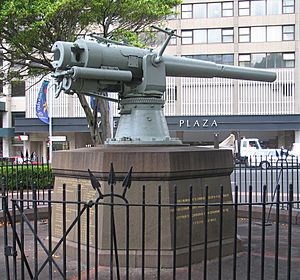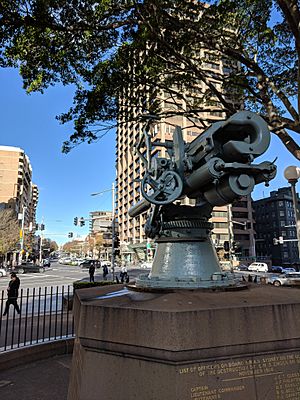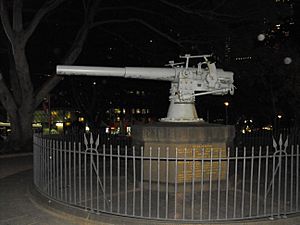HMAS Sydney I - SMS Emden Memorial facts for kids
Quick facts for kids HMAS Sydney I - SMS Emden Memorial |
|
|---|---|
 |
|
| Location | Hyde Park, corner of Liverpool and College Streets, Sydney central business district, City of Sydney, New South Wales, Australia |
| Built | 1917 |
| Architect | City of Sydney |
| Owner | City of Sydney |
| Official name: HMAS Sydney 1 - SMS Emden Memorial (moveable heritage item); Emden Gun | |
| Type | state heritage (movable / collection) |
| Designated | 27 February 2015 |
| Reference no. | 1946 |
| Type | Defence Objects (movable) |
| Category | Defence |
| Builders | Messrs Loveridge and Hudson, Redfern |
| Lua error in Module:Location_map at line 420: attempt to index field 'wikibase' (a nil value). | |
The HMAS Sydney I - SMS Emden Memorial is a historic gun from a German warship. It is now a war memorial and a war trophy. You can find it in Hyde Park, Sydney, at the corner of Liverpool and College Streets. The City of Sydney designed it, and it was built in 1917. This memorial is also known as the Emden Gun. It was added to the New South Wales State Heritage Register on 27 February 2015.
History of the Emden Gun
The German Ship SMS Emden
The SMS Emden was a German light cruiser. It had ten large guns and two torpedo tubes. At the start of World War I, the Emden was sent to attack shipping routes in the Indian Ocean.
From August to October 1914, the Emden was very successful. It captured or sank 21 ships, including a cruiser and a destroyer. It also attacked the port of Madras in India, destroying a lot of oil. The Emden's actions caused big problems for Allied navies. About 78 warships from four different navies were looking for it.
The Australian Ship HMAS Sydney I
The HMAS Sydney I was an Australian light cruiser with eight large guns. It is known as one of the most important Royal Australian Navy (RAN) warships of World War I.
In November 1914, the Sydney was helping to protect the first group of Australian and New Zealand troops. They were sailing from Western Australia to the Middle East. This strong protection was needed because the SMS Emden was a threat. The Sydney was sent to investigate a distress call from Direction Island.
The Battle and Destruction of the Emden
On 9 November 1914, the SMS Emden fired first. It hit the Sydney several times, causing some damage and a fire. But the Sydney soon found its range and hit the Emden over 100 times in 30 minutes.
The captain of HMAS Sydney I decided to make the Emden run aground. This happened on North Keeling, an island in the Cocos Keeling group. This battle was the Royal Australian Navy's first ship-to-ship victory. Sadly, 134 people from the Emden and four from the Sydney died.
The sinking of the SMS Emden was a huge victory for the Allies. It was also the first time the Royal Australian Navy had won a naval battle. This victory made Australians believe they could have their own strong navy.
After the battle, people wanted parts of the Emden as trophies. One of the guns, believed to be the one in Hyde Park, was salvaged. Several items were sent to England, and the rest, including large guns, came to Australia. In total, four complete guns were saved from the wreck. Three came to Australia, and one went to Great Britain.
How the Monument Was Built
In 1917, the Australian Government gave the Emden gun to the City of Sydney. It was given to Sydney because the victorious ship, HMAS Sydney, was named after the city. It was also hard to get relics from the Emden at that time.
The City of Sydney officially accepted the gun on 20 August 1917. The gun was put in its current spot as a memorial to HMAS Sydney's victory. The Lord Mayor of Sydney, R. D. Meagher, officially unveiled it on 21 December 1917.
At the unveiling, people said the gun showed the "success and efficiency" of the navy. They called it a war trophy "won by the youngest navy in the world". The Lord Mayor said Australians would feel proud when they saw this trophy.
Mr. J. Cook, the Minister of the Navy, said the memorial reminded them of Australia's self-government. He also said naval defence was key to the Empire's success. Cook stated that this gun was the first trophy of "our Australian Navy".
Australia had collected war trophies before, usually from the British Government. But the Emden gun was different. It was one of the first trophies to arrive in Australia from World War I. It was also the first gun to be turned into a memorial.
Most war memorials were placed in important and easy-to-reach places. This was part of a new trend after World War I. Many other trophies came to Australia later, in 1919. They were given out by State Trophy Committees.
After World War I, Australia had more war memorials per person than any other country. These memorials gave a way for communities to remember the soldiers who died. This was important because Australia sent only volunteers to the war, and many were lost.
Unlike statues, trophy guns were seen as representing everyone's effort. They did not list names, showing that it was a group effort. The Emden gun is special because it does list the names of those who died and those who served well.
After World War II
After World War II, memorials changed. Parks, halls, and swimming pools were built instead of just monuments. Many World War I trophies were lost over time due to damage or changing attitudes.
However, the Emden Gun has survived. This is likely because it has a protective fence. The City of Sydney Council has also had money to keep it in good condition. Its location in a well-known park also helps keep it important.
Today, the Emden Gun in Hyde Park reminds us of an important victory for the Australian Navy. It also reminds us of the Australian sailors involved. Wreaths are still laid at the memorial on days like ANZAC Day.
The Emden Gun is one of three complete 10.5 cm guns from the Emden in Australia. The others are in the Naval Heritage Collection in Sydney and the Australian War Memorial in Canberra. A fourth gun went to England, but its location is unknown.
Description of the Memorial
This monument celebrates the victory of HMAS Sydney I over the German ship SMS Emden. The 10.5 cm (4.1 inch) naval gun is in the south-eastern part of Hyde Park South. It is near the ANZAC War Memorial and Pool of Reflection.
The gun sits on an octagonal (eight-sided) stone base. Its muzzle (the front of the gun) faces Whitlam Square. An iron fence surrounds the memorial. The area inside the fence has large stone pavers.
The base has gold writing that tells about the memorial's opening. It also lists the names of those killed and wounded from HMAS Sydney. The names of officers and those who received medals are also there.
The gun itself has two main parts: a rotating base and the gun barrel. The base allows the gun to turn and move up and down. It is painted storm grey, with some wood parts like the handle.
Inscriptions
The monument has inscriptions on its four sides:
South Face:
This monument is surmounted by a "4 Gun taken
from the German raider "Emden" destroyed by H.M.A.S. Sydney
A Gift from the Commonwealth Government to the Citizens of Sydney.
West Face:
THIS MONUMENT WAS ERECTED BY THE MUNICIPAL COUNCIL OF SYDNEY TO COMMEMORATE THE DESTRUCTION OF THE GERMAN RAIDER "EMDEN" BY H.M.A.S. SYDNEY COMMANDED BY CAPTAIN JOHN C.T. GLOSSOP R.N. IN THE NAVAL ACTION COCOS ISLAND ON THE 9TH NOVEMBER 1914. THE MONUMENT BEING UNVEILED ON 21ST DECEMBER 1917 BY THE RIGHT HON. R.D. MEAGHER M.L.C LORD MAYOR OF SYDNEY, W.C. LAYTON THOMAS H. NESBITT, DEPUTY TOWN CLERK, R.H. BRODRICK ARCHITECT AND CITY BUILDING SURVEYOR.'
East Face:
KILLED IN ACTION: PETTY OFFICER T.LYNCH ABLE SEAMAN A. HOY ABLE SEAMAN R. SHARPE ORDINARY SEAMAN R. BELL WOUNDED: LIEUTENANT GEOFFREY C. HAMPDEN R.N. ABLE SEAMAN J. KINNIBURGH PETTY OFFICER M. HARVEY R. HORNE ABLE SEAMEN: J. BUTCHER T. GASCOIGNE A. HOOPER A. CROSBY B. GREEN SEAMAN W.MELDRUM SIGNALMAN 2ND CLASS T.STEVENSON SEAMAN 2ND CLASS T WILLIAMSON RECEIVED DISTINGUISHED SERVICE MEDAL: ABLE SEAMEN: W.TAYLOR H.COLLINS J.KINNIBURGH CHIEF PETTY OFFICER A.LAMBET SICK BERTH STEWARD T.MULLINS ABLE SEAMAN B.GREEN
North Face:
LIST OF OFFICERS ON BOARD H.M.A.S. SYDNEY ON THE OCCASION\ OF THE DESTRUCTION OF S.M.S. EMDEN ON 9TH NOVEMBER 1914. CAPTAIN J.C.T. GLOSSOP. LIEUTENANT COMMANDER J.F. FINLAYSON. LIEUNANT D.E.RAHILLY. B.O. BELL SALTER. F.L. CAVAYE. G.C. HAMPDEN. C. POE. R.C. GARSIA. SUB LIEUTENANT J.M.C. JOHNSTONE. ENGINEER LIEUTENANT COMMANDER A.W. COLEMAN. ENGINEER LIEUTENANT L.P.FOWLER. C. DENNIS. CHAPLIN V.A.S. LITTLE. STAFF PAYMASTER E.C. NORTON. ASSISTANT PAYMASTER E. KINGSFORD PAYMASTER. SURGEONS L. DARBY. A. TODD. GUNNERS G.B. SALTER. J.C. MCFARLANE. BOATSWAIN A.M. MARTIN. CARPENTER E.C. BEHENNA. ARTIFICER ENGINEER C.A. HUTCHISON.
Condition of the Gun
As of 2009, the gun was in very good condition. It had been cleaned and repainted in 2005. However, it was starting to show signs of rust again because it is outdoors. The base is also in very good condition. The Emden Gun is still very complete and well-preserved.
Changes Over Time
- 1915 - February: The gun was removed from the SMS Emden.
- 1917 - December: It was installed in Hyde Park.
- 1918 - Gold lettering was added to the base, and a name was corrected.
- 2005 - The gun was removed for cleaning and repairs, then put back.
Why the Memorial is Important
The HMAS Sydney I - SMS Emden Memorial is very important to New South Wales. It is a major part of the German ship SMS Emden, which the Royal Australian Navy defeated in its first ship-to-ship battle. This gun is one of only four saved from the cruiser, and three of them are in Australia.
The gun reminds us of the Australian naval crew who served and died in that battle. It is a symbol of victory and shows what Australia could achieve with its own navy. It is also an important part of a collection of items across the state that show Australia's military history. Today, the gun helps us remember world history.
The memorial also reminds us of the battle between HMAS Sydney I and SMS Emden. It honors the sailors from both sides who fought bravely. It also remembers those who died: four from the Royal Australian Navy and 134 from the SMS Emden. This gun is nationally important as the first naval war trophy of World War I.
The HMAS Sydney I - SMS Emden Memorial was added to the New South Wales State Heritage Register on 27 February 2015.
Historical Significance
The Emden Gun is historically important because it comes from the first ship defeated by the Royal Australian Navy (RAN) in a ship-to-ship battle. This battle was the RAN's first naval fight and the gun was Australia's first naval trophy from World War I. The sinking of the Emden was a big achievement for the new RAN. It showed that Australia could defend itself, helping to build a stronger national identity.
Association with Important People or Groups
The Emden Gun is important because it is linked to the World War I Armed Forces, especially the Navy. It is also connected to the people and groups involved in the Emden battle. The memorial has strong links to HMAS Sydney I, one of the most famous Royal Australian Navy ships of World War I. It also shows Australia's tradition of collecting war trophies.
Aesthetic and Design Importance
The Emden Gun is visually important as a clear and special monument at the entrance to Hyde Park. It has visual and physical connections to the ANZAC Memorial and Pool of Reflection.
Social and Cultural Importance
The Emden Gun is important to the Royal Australian Navy and others. It represents the early days of the Australian naval tradition. It also shows the national pride in the Allies' victory over the SMS Emden. This battle helped show that Australia could have its own successful navy. So, the Emden Gun is important to naval and war historians.
The Emden Gun also symbolizes the start of the Royal Australian Navy. It represents the idea that self-government could bring victory and power. It is an early example of using trophy guns as memorials. This was part of a bigger trend of building memorials for important wartime events and honoring those who fought and died for their country. These monuments become important places for people to take part in remembrance ceremonies.
Research Potential
The Emden Gun is a valuable resource for studying naval weapons from the early 1900s. It is a German 10.5 cm (4.1 inch) naval gun. It is part of a group of Emden guns and parts found in other places like HMAS Penguin, the Naval Heritage Centre in Sydney, and the Australian War Memorial in Canberra.
Rarity and Uniqueness
The Emden Gun is rare because it is one of only three complete guns of its type from the SMS Emden in Australia. There are only four examples of this type in the world. It is also one of a few large items saved from the Emden. It is believed to be the first gun used as a memorial. It is also the first naval war trophy of World War I.
The Emden Gun is also rare because it is one of the few war trophies Australia captured early in World War I. Soldiers often could not take many trophies when they had to retreat from early battles.
Representative Characteristics
The Emden Gun represents Australian war trophies from World War I. It also shows how memorials were first created in Australia. These memorials honored individuals and events in public places, especially after World War I. The Emden Gun shows an early focus on monuments for specific conflicts.



